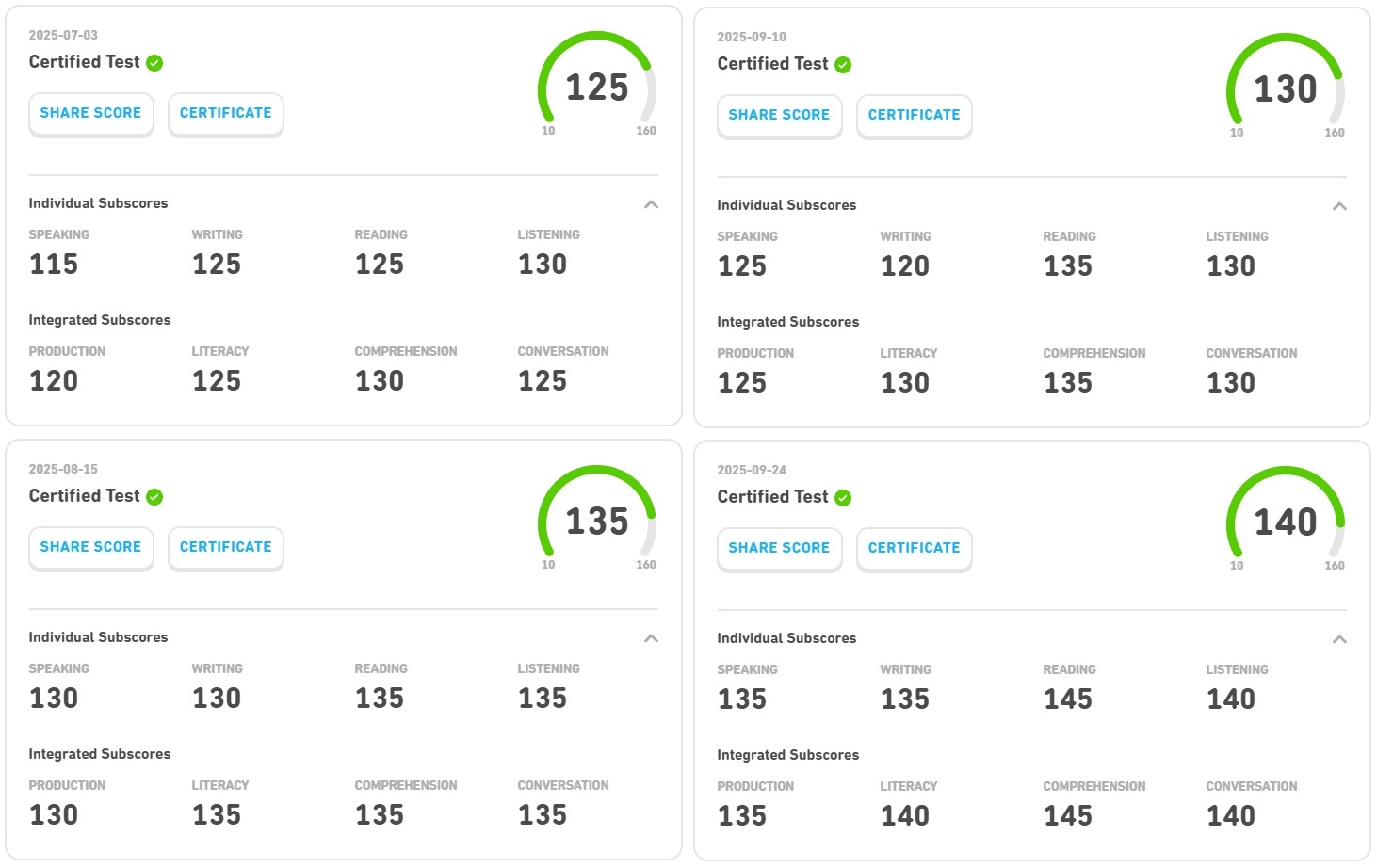El Examen de Práctica de Duolingo: Tu Guía Estratégica para Obtener 120+
El Duolingo English Test se ha convertido en una de las evaluaciones de competencia en inglés más populares del mundo, aceptada por más de 5.000 instituciones a nivel global. Pero aquí está la verdad: presentar el examen sin practicar adecuadamente es como correr una maratón sin entrenar. Puede que termines, pero no alcanzarás tu mejor rendimiento.

Los exámenes de práctica son tu arma secreta para el éxito en el DET. Te ayudan a comprender el formato del examen, identificar tus áreas débiles y generar la confianza necesaria para obtener un puntaje de 120 o más. En esta guía completa, te mostraremos exactamente cómo utilizar los exámenes de práctica de manera estratégica para maximizar tu puntaje y asegurar tu lugar en la institución de tus sueños.
Entendiendo tu Reporte de Resultados DET
Antes de adentrarte en las estrategias de práctica, necesitas entender hacia qué estás trabajando. El Duolingo English Test utiliza un sistema de puntuación sofisticado que evalúa tu dominio del inglés desde múltiples ángulos.
Puntaje General (Escala de 10-160)
Tu puntaje general es el número que la mayoría de las universidades observa primero. Va de 10 a 160, siendo común que los programas competitivos requieran entre 120 y 130 puntos. Este puntaje representa tu competencia general en inglés, pero no cuenta toda la historia.
Subpuntajes Individuales DET
El DET proporciona cuatro subpuntajes individuales que miden habilidades lingüísticas específicas:
Speaking: Tu habilidad para comunicarte verbalmente en inglés
Writing: Tu capacidad para expresar ideas claramente de forma escrita
Reading: Tu comprensión de textos escritos en inglés
Listening: Tu comprensión del inglés hablado
Cada uno de estos subpuntajes va de 10 a 160 y ayuda a las instituciones a entender tus fortalezas y debilidades específicas. Algunos programas pueden tener mínimos para subpuntajes, especialmente en áreas de alta comunicación como periodismo o relaciones internacionales.
Subpuntajes Integrados DET
Más allá de las habilidades individuales, el DET también mide qué tan bien integras diferentes habilidades lingüísticas:
Literacy (Reading + Writing): Mide tu dominio global del inglés escrito
Comprehension (Reading + Listening): Evalúa qué tan bien entiendes información en inglés
Conversation (Listening + Speaking): Evalúa tu habilidad de comunicación en tiempo real
Production (Writing + Speaking): Mide tu capacidad para producir inglés
Estos subpuntajes integrados ofrecen una visión más matizada de tus habilidades lingüísticas y pueden revelar patrones que los puntajes individuales podrían pasar por alto.
Por Qué Ambas Tipos de Subpuntajes DET Importan
Comprender tanto los subpuntajes individuales como los integrados es crucial para mejorar de manera focalizada. Por ejemplo, si tu puntaje de Literacy es considerablemente menor que tu Comprehension, indica que entiendes mejor el inglés de lo que puedes producirlo. Este conocimiento te ayuda a enfocar tu práctica donde tendrá mayor impacto.
Las universidades y los programas también pueden observar combinaciones específicas de subpuntajes. Los programas MBA suelen valorar mucho Conversation, mientras que los orientados a investigación podrían priorizar Literacy. Conocer las preferencias de tu institución objetivo te ayuda a practicar estratégicamente.
Dónde Encontrar Exámenes de Práctica DET de Calidad
No todos los exámenes de práctica son iguales. Utilizar los recursos correctos puede ser la diferencia entre perder tiempo y lograr un progreso real.
Examen de Práctica Oficial de Duolingo
El estándar dorado para practicar es el examen oficial de práctica de Duolingo, disponible gratis en el sitio web del Duolingo English Test. Este examen:
Utiliza el mismo formato que el examen real
Incluye todos los tipos de preguntas actuales
Ofrece una estimación de puntaje y desglose de subpuntajes
Se adapta a tu nivel de habilidad, igual que el examen real
Puede hacerse varias veces para seguir tu progreso
El examen oficial de práctica debe ser tu punto de partida. Haz uno antes de iniciar una preparación seria para establecer tu línea base, y utilízalo periódicamente para medir mejoras.
DET Practice: Tu Plataforma Integral de Preparación
Para quienes buscan puntajes de 120+ y se preparan en serio, DET Practice ofrece una solución completa. Como plataforma integral de preparación para el DET, DET Practice brinda:
Exámenes simulados de longitud completa: Estas pruebas replican el formato, duración y dificultad exactos del DET real. A diferencia de ejercicios cortos, los exámenes simulados completos te ayudan a desarrollar la resistencia y el ritmo esenciales para el éxito en el día del examen.
Análisis integral de subpuntajes: Tras cada examen de práctica, recibes desgloses detallados de todos tus subpuntajes, tanto individuales como integrados. Este feedback granular te permite identificar exactamente dónde enfocarte.
Banco de preguntas adaptativo: La plataforma utiliza una extensa base de datos de preguntas que se adapta a tu nivel, asegurando que siempre tengas un desafío apropiado sin sentirte abrumado ni aburrido.
Seguimiento de progreso: DET Practice realiza el seguimiento de tu desempeño a lo largo del tiempo, mostrándote tendencias y resaltando áreas de mejora o preocupación. Este enfoque basado en datos elimina las conjeturas en tu preparación.
Feedback potenciado por IA: Para las secciones de speaking y writing, recibes retroalimentación instantánea y detallada sobre tus respuestas, incluyendo sugerencias para mejorar vocabulario, gramática, coherencia y pronunciación.
La combinación de exámenes oficiales de práctica y los simulados de DET Practice te da todo lo que necesitas para prepararte de forma eficaz y eficiente.






